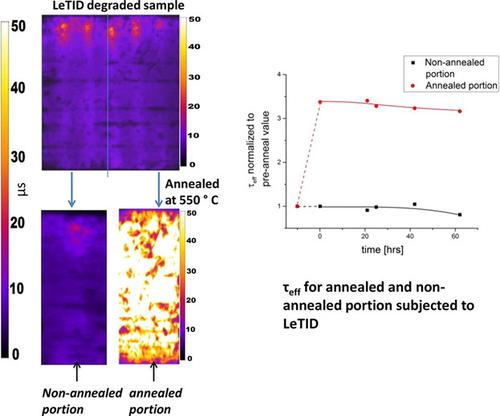Our official English website, www.x-mol.net, welcomes your
feedback! (Note: you will need to create a separate account there.)
Optimization of Belt Furnace Anneal to Reduce Light and Elevated Temperature Induced Degradation of Effective Carrier Lifetime of P‐Type Multicrystalline Silicon Wafers
Solar RRL ( IF 6.0 ) Pub Date : 2018-06-06 , DOI: 10.1002/solr.201800070 Romika Sharma 1, 2 , Armin G. Aberle 1, 2 , Joel B. Li 2
Solar RRL ( IF 6.0 ) Pub Date : 2018-06-06 , DOI: 10.1002/solr.201800070 Romika Sharma 1, 2 , Armin G. Aberle 1, 2 , Joel B. Li 2
Affiliation

|
Light and elevated temperature induced degradation (LeTID) of the effective charge carrier lifetime significantly lowers the efficiency of multicrystalline silicon (mc‐Si) solar cells and is a major challenge currently faced by the silicon photovoltaic industry. Optimization of the temperature profile used in the rapid thermal anneal (RTA) step of the metallization line has been found to significantly reduce LeTID of mc‐Si solar cells. Hence, the authors experimentally study the impacts of varying the RTA process parameters on the LeTID behavior of mc‐Si lifetime samples. It is shown that a low peak temperature, slow ramp‐up rate (slow belt speed) reduce LeTID in mc‐Si lifetime samples. Also, subsequent dark anneal at a moderate temperature (≈300–550 °C) further reduces LeTID. Samples already subjected to LeTID conditions also benefit from the post‐degradation dark anneal. The recovered effective carrier lifetime of the degraded samples dark annealed at 550 °C is even higher than the post‐firing effective carrier lifetime value. The defect state achieved post‐dark anneal at 550 °C is stable for the studied period of ≈60 h, unlike the well‐known case of low‐temperature dark anneals (<200 °C) where samples degrade again when subjected to LeTID conditions. The authors believe that the optimized conditions identified in this work can be applied to mass‐produced mc‐Si solar cells.
中文翻译:

优化带式炉退火工艺以减少光和高温引起的P型多晶硅晶片有效载流子寿命的降低
有效电荷载流子寿命的光照和高温诱导降解(LeTID)大大降低了多晶硅(mc-Si)太阳能电池的效率,这是硅光伏行业目前面临的主要挑战。已经发现,优化金属化生产线的快速热退火(RTA)步骤中使用的温度曲线可以显着降低mc-Si太阳能电池的LeTID。因此,作者通过实验研究了改变RTA工艺参数对mc-Si寿命样品的LeTID行为的影响。结果表明,较低的峰值温度,较慢的升温速率(较慢的皮带速度)会降低mc-Si寿命样本中的LeTID。而且,随后在中等温度(≈300–550°C)下进行的暗退火进一步降低了LeTID。已经经历了LeTID条件的样品也可以从降解后的暗退火中受益。在550°C下进行暗退火的降解样品的恢复的有效载流子寿命甚至高于发射后的有效载流子寿命值。在550°C的暗退火后达到的缺陷状态在大约60 h的时间内是稳定的,这与低温暗退火(<200°C)的众所周知的情况不同,在低温退火中,样品在经受LeTID条件下会再次降解。作者认为,这项工作中确定的优化条件可以应用于大规模生产的mc-Si太阳能电池。在550°C的暗退火后达到的缺陷状态在大约60 h的时间内是稳定的,这与低温暗退火(<200°C)的众所周知的情况不同,在低温退火中,样品在经受LeTID条件下会再次降解。作者认为,这项工作中确定的优化条件可以应用于大规模生产的mc-Si太阳能电池。在550°C的暗退火后达到的缺陷状态在大约60 h的时间内是稳定的,这与低温暗退火(<200°C)的众所周知的情况不同,在低温退火中,样品在经受LeTID条件下会再次降解。作者认为,这项工作中确定的优化条件可以应用于大规模生产的mc-Si太阳能电池。
更新日期:2018-06-06
中文翻译:

优化带式炉退火工艺以减少光和高温引起的P型多晶硅晶片有效载流子寿命的降低
有效电荷载流子寿命的光照和高温诱导降解(LeTID)大大降低了多晶硅(mc-Si)太阳能电池的效率,这是硅光伏行业目前面临的主要挑战。已经发现,优化金属化生产线的快速热退火(RTA)步骤中使用的温度曲线可以显着降低mc-Si太阳能电池的LeTID。因此,作者通过实验研究了改变RTA工艺参数对mc-Si寿命样品的LeTID行为的影响。结果表明,较低的峰值温度,较慢的升温速率(较慢的皮带速度)会降低mc-Si寿命样本中的LeTID。而且,随后在中等温度(≈300–550°C)下进行的暗退火进一步降低了LeTID。已经经历了LeTID条件的样品也可以从降解后的暗退火中受益。在550°C下进行暗退火的降解样品的恢复的有效载流子寿命甚至高于发射后的有效载流子寿命值。在550°C的暗退火后达到的缺陷状态在大约60 h的时间内是稳定的,这与低温暗退火(<200°C)的众所周知的情况不同,在低温退火中,样品在经受LeTID条件下会再次降解。作者认为,这项工作中确定的优化条件可以应用于大规模生产的mc-Si太阳能电池。在550°C的暗退火后达到的缺陷状态在大约60 h的时间内是稳定的,这与低温暗退火(<200°C)的众所周知的情况不同,在低温退火中,样品在经受LeTID条件下会再次降解。作者认为,这项工作中确定的优化条件可以应用于大规模生产的mc-Si太阳能电池。在550°C的暗退火后达到的缺陷状态在大约60 h的时间内是稳定的,这与低温暗退火(<200°C)的众所周知的情况不同,在低温退火中,样品在经受LeTID条件下会再次降解。作者认为,这项工作中确定的优化条件可以应用于大规模生产的mc-Si太阳能电池。















































 京公网安备 11010802027423号
京公网安备 11010802027423号